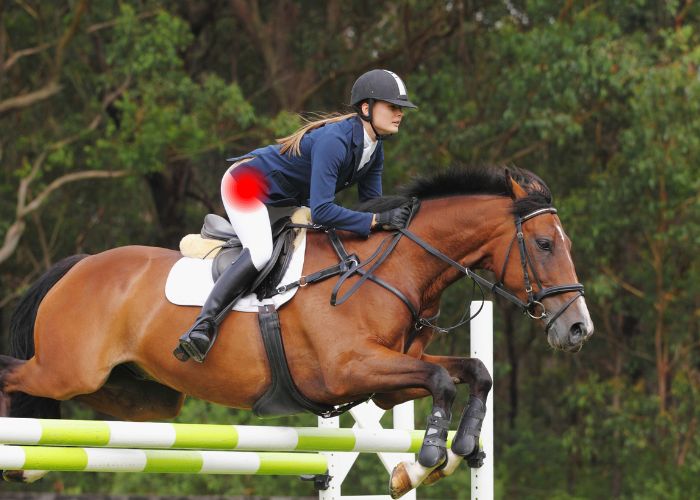What is Snapping Hip Syndrome?
The hip joint is formed by the insertion of the head of the femur (thigh bone) into the socket of the acetabulum (pelvis). Encompassing this joint are ligaments that are responsible for joint stability and security. Lying above these ligaments are the connecting tendons for the hamstring and gluteal muscles. These tendons attach to two bony prominences on the femur: the lesser trochanter, found on the inner femur, and the greater trochanter, located on the outer femur. Repetitive hip movements can lead to the tightening of these muscles and tendons. When these tight muscles or tendons slide over the greater trochanter of the femur, a “snapping” sensation can occur known as Snapping Hip Syndrome. Athletes that perform repeated bending motions have a higher risk of experiencing Snapping Hip Syndrome with dancers being particularly susceptible. Young athletes are also vulnerable as muscle tightness in the hip is common with adolescent growth spurts. Dr. Ronak Mukesh Patel, orthopedic hip specialist serving patients in Sugar Land, Pearland, and the Houston, Texas area, has the knowledge and understanding as well as substantial experience in treating patients who have experienced Snapping Hip Syndrome.
What areas of the hip can be affected by Snapping Hip Syndrome?
There are a number of areas within the hip where Snapping Hip Syndrome can originate. Typically, any area where the muscles and tendons slide over bony eminences are at risk for developing this hip condition.
- Anterior: The rectus femoris tendon has a back-and-forth motion across the femoral head with bending and straightening of the hip. This back-and-forth tendon movement creates a “snapping” sensation that is felt at the front of the hip. The iliopsoas tendon can also create a “snapping” sensation as it passes over the iliopectineal eminence, a bony protrusion of the pelvic bone. This typically occurs when the hip is extended from a flexed position.
- Posterior: The hamstring tendon can generate a “snapping” sensation if it catches against the ischial tuberosity of the pelvic bone. Pain in the buttocks typically occurs from this form of Snapping Hip Syndrome.
- External: Where the iliotibial (IT) band meets the greater trochanter on the femur is the most common location for Snapping Hip Syndrome. Because the IT band is always tight, the “snapping” sensation occurs when the IT band passes over the greater trochanter.
- Internal: There is a ring of cartilage called the labrum that lines the hip socket (acetabulum). This ring can become damaged and/or dislodged into the joint space of the hip after a traumatic injury to the hip. Although this is not a true form of Snapping Hip Syndrome, a “catching” sensation of the hip joint can be felt limiting range of motion of the hip.
What are the symptoms of Snapping Hip Syndrome?
The most common complaint associated with Snapping Hip Syndrome is a “snapping” sensation in or around the hip that occurs with joint movement. Some individuals even report an audible “popping” sound with certain hip movements. Other common symptoms of Snapping Hip Syndrome can include:
- Pain that worsens with physical activity
- Decreased range of motion of the hip
- Swelling of the hip with an area that is warm to the touch
- Activities of daily living can become difficult to perform
- Leg weakness, particularly with lifting the leg
How is Snapping Hip Syndrome diagnosed?
Through an interview, Dr. Patel will gather a comprehensive medical history with a focus on any prior hip injuries or other hip conditions. A thorough physical examination is the key to establishing a diagnosis. Dr. Patel will evaluate the hip’s range of motion and perform special tests to reproduce the pain and snapping symptoms. Based on any findings, Dr. Patel may request some diagnostic imaging studies such as x-rays and magnetic resonance imaging (MRI). These imaging studies can identify any underlying conditions such as bone-related injuries or damage to the soft tissue structures of the hip joint.
What is the treatment for Snapping Hip Syndrome?
Non-surgical treatment:
Snapping Hip Syndrome is a condition that frequently resolves spontaneously, so the majority of patients respond well to non-surgical therapies alone. Modifying and/or reducing physical activity is essential to the healing process. A combination of rest, ice, massage therapy, and non-steroidal anti-inflammatory medications (NSAIDs) is encouraged for pain and inflammation management. A tailored physical therapy program with an emphasis on hip stretching often provides the best recovery outcome in addition to preventing another injury. Occasionally, targeted injections with steroid, platelet-rich plasma (PRP), or stem cells may be utilized.
Surgical treatment:
Some individuals with additional underlying hip conditions, such as a cartilage injury, loose bodies, or femoroacetabular impingement (FAI), may not respond well to non-surgical treatment measures. These instances typically require surgical intervention to correct these underlying issues. If surgery is necessary, Dr. Patel will formulate an individualized treatment plan to meet the patient’s specific needs. Dr. Patel is frequently able to accomplish the necessary revisions through a minimally invasive arthroscopic procedure involving a small camera (arthroscope) and specialized surgical instruments. A postoperative rehab protocol directed by Dr. Patel is essential to a full recovery after surgery for Snapping Hip Syndrome.
Snapping Hip Syndrome Specialist

Are you experiencing a snapping or popping sensation in the hip that occurs with joint movement? If so, you may have a hip condition known as snapping hip syndrome. This hip condition can cause pain, decreased range of motion and leg weakness. Snapping hip syndrome specialist, Doctor Ronak Mukesh Patel, provides diagnosis as well as surgical and nonsurgical treatment options for patients in Houston, Sugar Land, and Pearland, TX who are experiencing snapping hip syndrome. Contact Dr. Patel’s team today!








